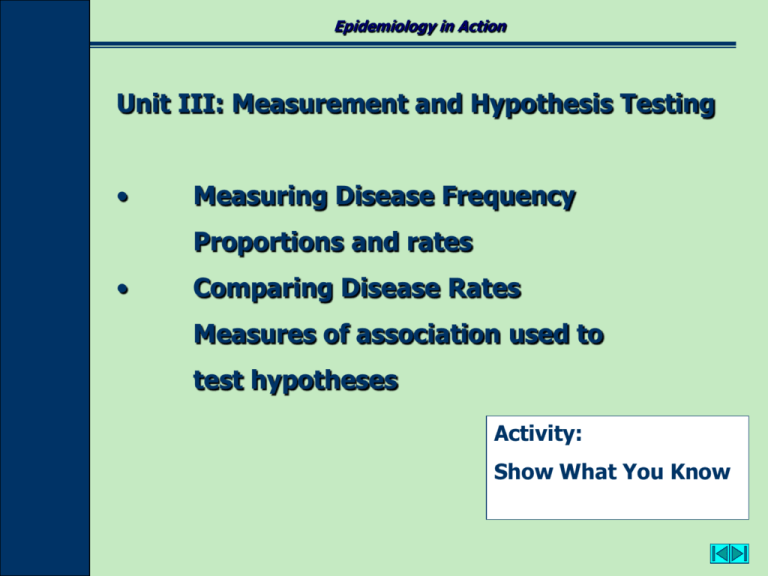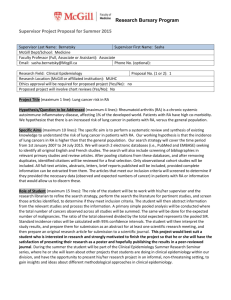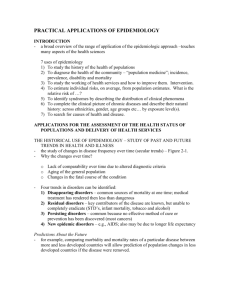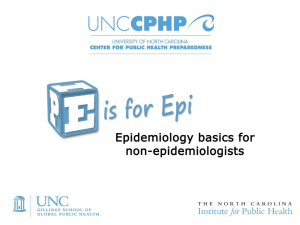holmstrom_slides_ unit _3. ppt
advertisement

Epidemiology in Action Unit III: Measurement and Hypothesis Testing • Measuring Disease Frequency Proportions and rates • Comparing Disease Rates Measures of association used to test hypotheses Activity: Show What You Know Epidemiology in Action 2 Measuring Disease Frequency Disease Yes Disease No TOTAL Exposed Yes A B A+B Exposed No C D C+D TOTAL A+C B+D A+C+D In any study, one of the first steps is to gather data. The chart above is called a Chi Square, and it is the basic statistic used to test for the significance of any differences noted in distribution of disease or risk. Rates needed for epidemiological analysis can be calculated from this basic table. Epidemiology in Action Chi Square 3 Disease Yes Disease No TOTAL Exposed Yes A B A+B Exposed No C D C+D TOTAL A+C B+D A+C+D A = the # who are exposed and have the disease B=the number who are exposed and do not have the disease C=the number who are not exposed and have the disease D=the number of individuals who are not exposed and don’t have the disease A+B+C+D= the total number in the population being studied A+B=the total number exposed C+D=the total number not exposed A=C=the total number with disease B+D=the total number without disease Epidemiology in Action 4 Measuring Disease Frequency In epidemiology, occurrence of a condition must be related to the “population at risk”. Common measures of disease frequency are Prevalence rate and Incidence rate. Prevalence rate = the proportion of a population that are cases at a point in time. For example, what PROPORTION Of the the U.S. population Has HIV/AIDS right now? For current HIV/AIDS statistics, check the link below: Source: LC,/1985,David Lance Goines. Link: CDC - Division of HIV/AIDS Prevention - Basic Statistics Epidemiology in Action 5 Prevalence Rate Prevalence Rate: the proportion of people in a population who have a condition/attribute at a specified time. Prevalence=number of existing cases divided by total population For example, a hypothetical survey of 2477 persons showed that 310 were heavy smokers. The prevalence of the condition, heavy smoking, was the number of people who smoke heavily at a specified time divided by the total population 310 x 100 = 12.5% 2477 Epidemiology in Action 6 Incidence Rate = rate at which NEW cases occur in a population during a specified time period. For example, what is the Incidence Rate for new cases of AIDS in the U.S. during the last year? Source: LC,/1985,David Lance Goines. For current HIV/AIDS statistics, check the link below: Link: CDC - Division of HIV/AIDS Prevention - Basic Statistics Epidemiology in Action 7 Incidence Rate rate at which NEW cases occur in a population during a specified time period. For example, in a hypothetical study of 2390 college women, 482 drank two or more glasses of alcohol a day. Twenty-seven of the 482 two-a-day women drinkers over a specified time period were in car accidents related to alcohol use. The incidence rate of alcohol-related car accidents was: Alcohol-related car accidents divided by two-a-day drinkers. 27 482 X 100 = 5.6% Wartenberg, Daniel. (2000). Analytical Methods Used by Epidemiologists.. FACSNET Reporting Tools: online, September 27, 2002 Epidemiology in Action 8 Measures Used to Show Statistical Correlation: • Is this disease increasing in incidence? • Is it more frequent in my area? • Does its incidence correlate with some suspected cause? • Have things changed since we introduced control measures? Source;LC/Jerome Henry Rothstein, 1936-38 These are all questions we answer by setting two sets of rates side by side and comparing them. Three common measures we use to compare rates are Relative Risk, Odds Ratio, and Attributable Risk For information on cancer and the link to nutrition go to: Epi Research: Nutritional Epidemiology Epidemiology in Action Relative Risk • Calculated to identify differences in disease rates between exposed and unexposed groups. It is the most common measure of association used by epidemiologists, because it can be estimated by a wider range of study designs. • Relative Risk = Rate of condition among exposed divided by rate of condition among unexposed For example, if lung cancer mortality rate among smokers is 131 per 100,000, and the lung cancer rate among nonsmokers is 11 per 100,000, then Relative Risk = 131/11=11.9 Relative Risk = 1 means no difference Relative Risk > 1 shows existence of an association between exposure and disease, and there is an association between smoking and lung cancer. 9 Epidemiology in Action Odds Ratio • Calculated to identify likelihood of exposure to risk when comparing two groups, one with and one without disease. • Odds Ratio = Exposure odds in disease group divided by exposure odds in non-disease group If the prevalence of smoking among lung cancer patients is 95 per 100, and the prevalence of smoking among people without lung cancer is 25 per 100, then Odds Ratio = 95/25=3.8 Ratio = 1, no association Ratio > 1, association between exposure and disease …..And there is an association between lung cancer and smoking. Read about some interesting studies on youth and smoking at: Epidemiology of Youth Drug Abuse - Research Findings 5/01 10 Epidemiology in Action 11 Based on the Odds Ratio formula, what is the Odds Ratio for each disease status in the famous smoking study? Smoking and Carcinoma of the Lung Disease Status # of smokers # of nonsmokers Males Lung cancer 647 (99.7%) 2 (0.3%) Males Controls 622 (95.8%) 27 (4.2%) Females Lung cancer 41 (46.7%) 19 31.7%) Females Controls 28 (46.7%) 32 53.3% P-value 0.00000064 0.016 Doll R. Bradford, Hill A. Smoking and carcinoma of the lung: preliminary report. British Medical Journal 1950, 2: 739-748. Epidemiology of Youth Drug Abuse - Research Findings 5/01 Epidemiology in Action 12 Attributable Risk Attributable Risk is the proportion of exposed cases that would not have gotten the disease if they had not been exposed. For example: How many MORE people will get cancer in a town that has arsenic contamination due to industrial pollution? To find out more about the link between arsenic poisoning and cancer link to: UC Berkeley Arsenic Research Program Source: LC/1951 The Attributable Risk would be useful to know in this case, because we may then be able to attribute this excess of disease to the risk factor we’re studying. Epidemiology in Action 13 Attributable Risk If we subtract the rate of disease in a population that does not have a risk factor from the rate of disease in a population that DOES have a risk factor, we get the Attributable Risk. Rate of Disease/ exposed minus Rate of Disease/ not exposed = Attributable Risk. Source: LC/1951 For example: Let’s say that in a town exposed to arsenic from pollution, we find ten cases of one type of cancer in 2000 people over a 10-year period of observation. The rate, then, is 4 cases per 10,000 people per year. Comparing the rate in this town to that estimated for the entire United States, we find that this town had an excess of four cases per 10,000 people per year (5 cases in the town minus one case expected based on national data, per 10,000 persons per year. We may then attribute that excess to arsenic from pollution. Wartenberg, Daniel. (2000). Analytical Methods Used by Epidemiologists.. FACSNET Reporting Tools: online, September 27, 20 Epidemiology in Action 14 Show What You Know: Assignment STEP I: Using the statistical databases we have become familiar with so far, find REAL examples of the following things. Then, explain what that statistic MEANS in terms of the data you are looking at. Note: you can find them already calculated, or you can construct them by working backward/forward with a set of data. For all examples, document correctly where the data comes from. 1. A chi square. You may find one already in place, or you can construct one working backward from data you find. 2. A prevalence rate – calculate, if necessary. 3. An incidence rate – calculate, if necessary. 4. An example of relative risk – calculate, if necessary. 5. An example of odds ratio – calculate, if necessary. 6. An example of attributable risk – calculate, if necessary. Epidemiology in Action 15 Show What You Know: Assignment STEP II: Create two hypothetical studies, in which you use all of these statistical measures (you don’t have to use all six in each studyuse each at least once in one or the other of the studies). For your hypothetical study, identify the following: Target population, type of study. Useful sources for data that measures frequency: Office of Population Research, Princeton University PopNet Population Statistics





